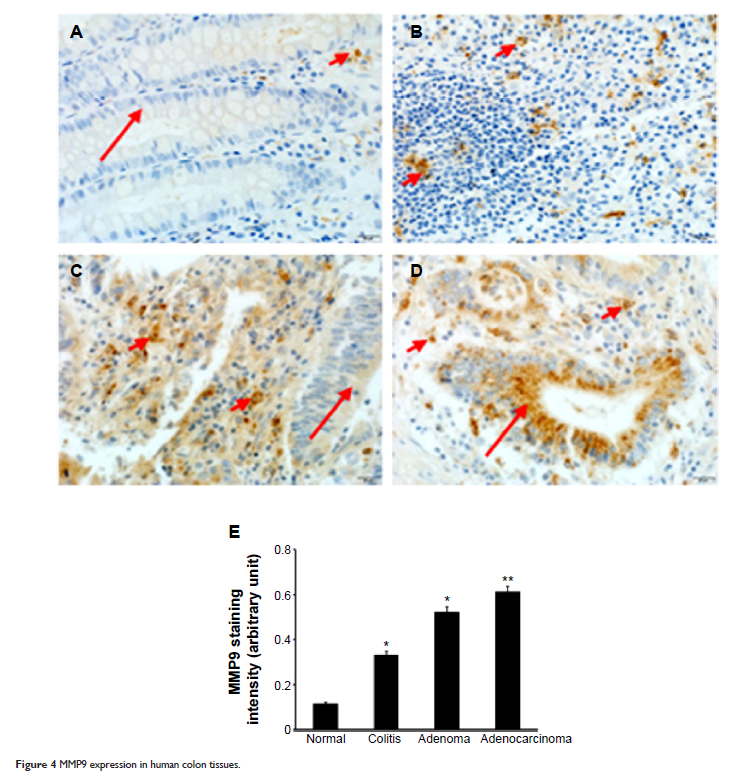9 5 9 4 4
论文已发表
注册即可获取德孚的最新动态
IF 收录期刊
- 3.3 Breast Cancer (Dove Med Press)
- 3.4 Clin Epidemiol
- 2.5 Cancer Manag Res
- 2.9 Infect Drug Resist
- 3.5 Clin Interv Aging
- 4.7 Drug Des Dev Ther
- 2.7 Int J Chronic Obstr
- 6.6 Int J Nanomed
- 2.5 Int J Women's Health
- 2.5 Neuropsych Dis Treat
- 2.7 OncoTargets Ther
- 2.0 Patient Prefer Adher
- 2.3 Ther Clin Risk Manag
- 2.5 J Pain Res
- 2.8 Diabet Metab Synd Ob
- 2.8 Psychol Res Behav Ma
- 3.0 Nat Sci Sleep
- 1.8 Pharmgenomics Pers Med
- 2.7 Risk Manag Healthc Policy
- 4.2 J Inflamm Res
- 2.1 Int J Gen Med
- 4.2 J Hepatocell Carcinoma
- 3.7 J Asthma Allergy
- 1.9 Clin Cosmet Investig Dermatol
- 2.7 J Multidiscip Healthc

人类结肠癌与增加的白细胞介素-17 炎症反应相关联
Authors Xie Z, Qu Y, Leng Y, Sun W, Ma S, Wei J, Hu J, Zhang X
Published Date March 2015 Volume 2015:9 Pages 1679—1689
DOI http://dx.doi.org/10.2147/DDDT.S79431
Received 17 December 2014, Accepted 2 February 2015, Published 18 March 2015
Abstract: Inflammation
is known to contribute to carcinogenesis in human colorectal cancer.
Proinflammatory cytokine interleukin-17 (IL-17 or IL-17A) has been shown to
play a critical role in colon carcinogenesis in mouse models. However, few studies
have investigated IL-17A in human colon tissues. In the present study, we
assessed IL-17-driven inflammatory responses in 17 cases of human colon
adenocarcinomas, 16 cases of human normal colon tissues adjacent to the
resected colon adenocarcinomas, ten cases of human ulcerative colitis tissues
from biopsies, and eight cases of human colon polyps diagnosed as benign
adenomas. We found that human colon adenocarcinomas contained the highest
levels of IL-17A cytokine, which was significantly higher than the IL-17A
levels in the adenomas, ulcerative colitis, and normal colon tissues (P <0.01). The levels of IL-17
receptor A (IL-17RA) were also the highest in human colon adenocarcinomas,
followed by adenomas and ulcerative colitis. The increased levels of IL-17A and
IL-17RA were accompanied with increased IL-17-driven inflammatory responses,
including activation of extracellular signal-regulated kinase (ERK)1/2 and
c-Jun N-terminal kinase (JNK) pathways, increase in expression of matrix
metalloproteinase (MMP)9, MMP7, MMP2, B-cell lymphoma (Bcl-2), and cyclin D1,
decrease in Bcl-2-associated X protein (BAX) expression, and increase in
vascular endothelial growth factor (VEGF) and VEGF receptor (VEGFR) expression
that were associated with increased angiogenesis. These findings suggest that
IL-17 and its signaling pathways appear as promising new targets in the design
and development of drugs for cancer prevention and treatment, particularly in
colorectal cancer.
Keywords: colitis, colorectal
cancer, inflammation, IL-17
